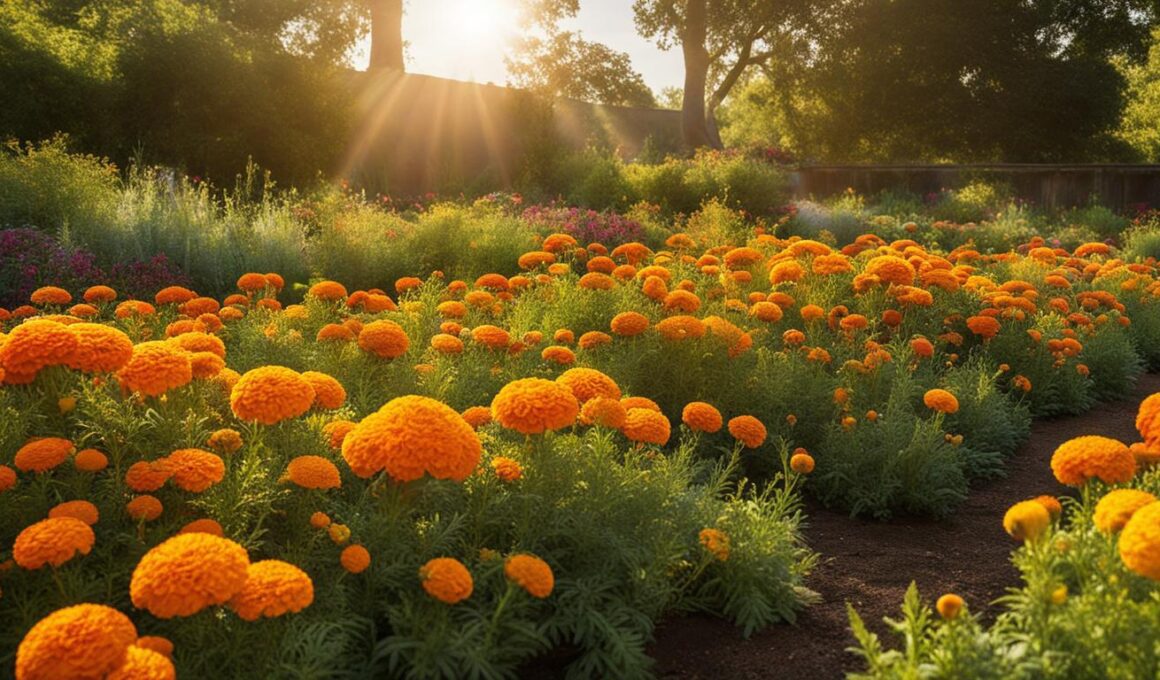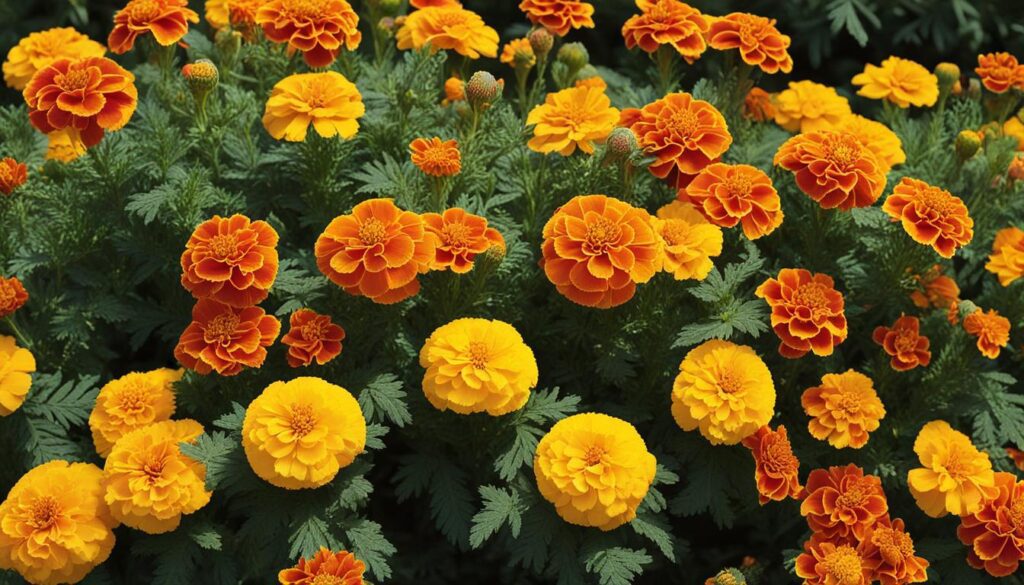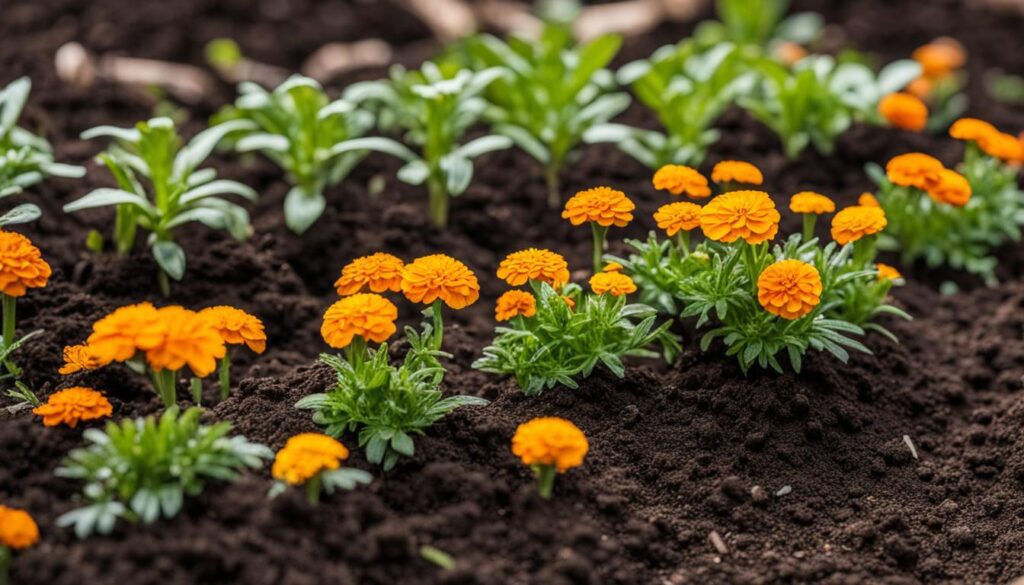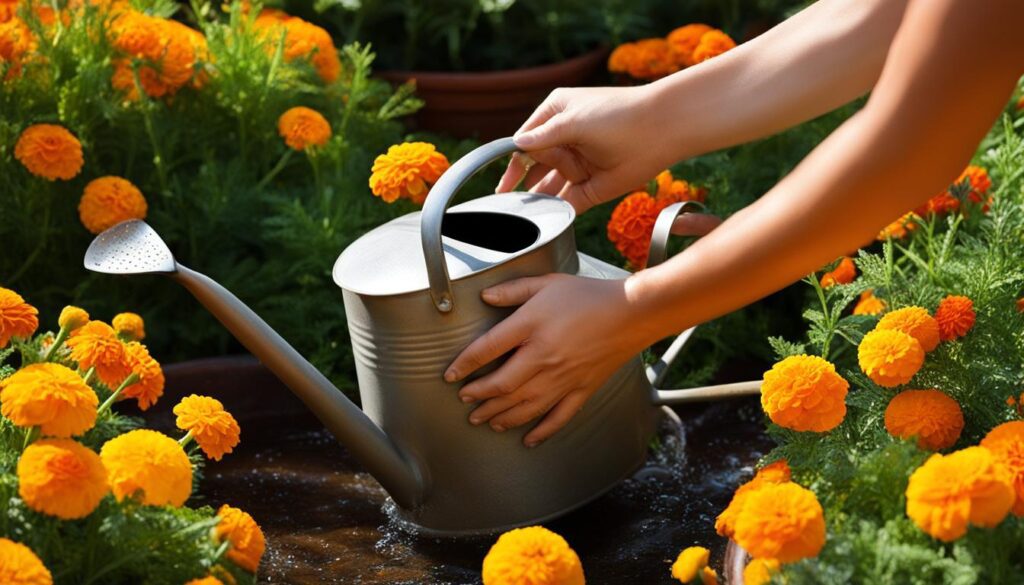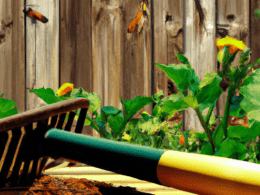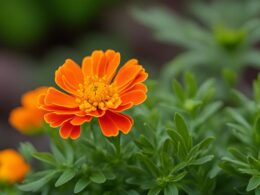Marigolds are a popular choice for garden enthusiasts looking to add a splash of color to their outdoor space. But are they annuals or perennials? In this ultimate guide, we’ll explore the fascinating world of marigolds and their classification as annuals or perennials, as well as provide valuable tips on growing these beautiful flowers.
Key Takeaways:
- Marigolds can be both annuals and perennials.
- French and African marigolds are commonly grown as annuals.
- Perennial marigolds include Mexican marigold, mountain marigold, and Mexican mint marigold.
- To grow marigolds from seeds, you can start them indoors or sow them directly in the ground.
- Marigolds require regular watering, deadheading for continuous blooming, and benefit from mulching.
Different Types of Marigolds
Marigolds come in various types, each with its own unique characteristics. Whether you’re looking for vibrant colors, different plant sizes, or specific growth habits, there is a marigold variety to suit your preferences.
Here are some of the different types of marigolds you can consider for your garden:
- French Marigolds: These marigolds are smaller and bushier, making them a great option for borders or bedding plants. They produce delicate, compact flowers in a wide range of colors.
- African Marigolds: Known for their large, showy flowers, African marigolds are taller and more upright compared to other varieties. They come in vibrant shades of yellow, orange, and red.
- Signet Marigolds: Signet marigolds are smaller and more delicate. They have lacy foliage and produce small, edible flowers that add a spicy flavor to salads and other dishes.
- Perennial Marigolds: While most marigolds are annuals, there are a few perennial varieties available. Mexican marigold, mountain marigold, and Mexican mint marigold are examples of perennial marigolds that can grow as shrubs and reach heights of up to 6 feet.
Each type of marigold has its own distinct beauty and growing requirements. Consider the specific characteristics of each variety to find the perfect marigolds for your garden.
Growing Marigolds from Seeds
One of the most rewarding ways to grow marigolds is from seeds. Whether you choose to start them indoors or sow them directly in the ground, growing marigolds from seeds allows you to experience the complete life cycle of these beautiful flowers.
If you prefer to start marigold seeds indoors, begin about four weeks before the last frost date in your area. Use a well-drained planting mix and sow the seeds about ¼ inch deep. Keep the soil lightly moist and maintain a room temperature environment. Within 6-10 days, you should see the marigold seeds germinate, sprouting delicate green seedlings.
Alternatively, you can also sow marigold seeds directly in the ground once the soil has warmed up. Choose a sunny location with fertile soil and prepare it by removing any weeds and loosening the soil. Sow the marigold seeds about ¼ inch deep and cover them gently with soil. Water the area regularly, keeping the soil moist until the seeds germinate and the seedlings emerge.
Whether starting marigold seeds indoors or sowing them directly, remember to thin the seedlings once they have a few sets of true leaves. This ensures that each plant has enough space to grow and flourish. Enjoy the process of watching your marigold seeds transform into vibrant, blooming flowers that will brighten up your garden.
Benefits of Growing Marigolds from Seeds:
- Cost-effective: Growing marigolds from seeds is a budget-friendly option compared to buying mature plants.
- Variety of choices: When starting from seeds, you have access to a wider range of marigold varieties and colors than what may be available as potted plants.
- Satisfaction of nurturing: By growing marigolds from seeds, you get to experience the full process of caring for the plants and witnessing their growth from tiny seeds to beautiful flowers.
- Greater control: Starting from seeds allows you to have better control over the growing conditions, ensuring that your marigolds receive the right amount of light, water, and nutrients.
Care and Maintenance of Marigolds
Marigolds are relatively easy to care for and can bring vibrant colors to your garden. Here are some important tips for caring for your marigold plants:
Watering Marigolds
Proper watering is essential for the health of your marigolds. It is best to water them regularly, allowing the soil to dry out slightly between waterings. Overwatering can lead to root rot, so be careful not to overdo it. When watering, aim for the base of the plant to avoid wetting the foliage, which can encourage fungal diseases.
Deadheading Marigolds
Deadheading is a simple but crucial task to keep your marigolds blooming throughout the season. By removing faded flowers, you’re encouraging the plant to produce more blooms. Use your fingers or sharp scissors to snip off the dead flowers at their base. Regular deadheading also prevents the marigold from going to seed too quickly.
Caring for Marigolds
- Marigolds prefer full sun but can tolerate some partial shade.
- They are not fussy about soil types and can thrive in moderately fertile soil.
- Applying a layer of organic mulch around the plants can help suppress weeds and retain moisture in the soil.
- Unlike some other plants, marigolds are relatively resistant to pests and diseases. However, if you notice any issues, such as aphids or fungal infections, treat them promptly to prevent further damage.
By following these care tips, your marigolds will reward you with abundant blooms and cheerful colors, adding beauty to your garden throughout the growing season.
Edible and Deer-Resistant Marigolds
Did you know that some marigolds are not only beautiful but also edible? Signet marigolds, in particular, have petals with a spicy flavor that can be used as a garnish in various dishes. Their vibrant colors make them an attractive addition to salads, soups, and even cocktails. So, if you’re looking to add a unique and flavorful touch to your culinary creations, consider growing these edible marigolds in your garden.
When it comes to marigolds and dogs, you’ll be relieved to know that these flowers are generally safe for your four-legged friends. While eating marigolds may cause an upset stomach in dogs, they are not considered toxic. However, it’s always a good idea to monitor your dog’s behavior around plants and consult with a veterinarian if you have any concerns.
Marigolds are not only prized for their beauty and taste but also for their deer-resistant properties. The strong scent of marigolds acts as a natural deterrent, helping to keep deer at bay. Planting marigolds around your garden or using them as a border can help protect your plants from being nibbled on by these animals. Keep in mind that while marigolds are deer-resistant, they may not be completely foolproof, so it’s always a good idea to combine other deer-resistant strategies for optimal results.
Planting and Growing Tips for Marigolds
When it comes to planting and growing marigolds, there are a few key tips to keep in mind. Marigolds thrive in full sun conditions, so make sure to choose a location in your garden that receives at least six hours of direct sunlight each day. This will ensure that your marigolds develop strong, healthy blooms.
When planting marigolds, it’s important to prepare the soil properly. Marigolds prefer moderately fertile soil that is well-draining. Before planting, loosen the soil and remove any weeds or debris. It can also be beneficial to amend the soil with organic matter, such as compost, to provide additional nutrients.
When it comes to spacing marigolds, it’s important to provide adequate room for each plant to grow. The spacing between plants will vary depending on the variety, but a general guideline is to plant them about 6-12 inches apart. Proper air circulation between the plants is important to prevent moisture buildup and reduce the risk of diseases.
When watering marigolds, it’s important to strike the right balance. While marigolds require regular watering, they also prefer the soil to dry out slightly between waterings. Avoid overwatering, as this can lead to root rot and other issues. Water at the base of the plant to avoid wetting the leaves, as this can also increase the risk of diseases.
By following these planting and growing tips, you can ensure that your marigolds thrive and provide a beautiful burst of color in your garden.
Conclusion
Marigold gardening offers a range of options for both annual and perennial flowers. These versatile plants can be easily grown and require minimal maintenance, making them a popular choice for gardeners. Whether you prefer the vibrant colors of the annual varieties or the long-lasting beauty of perennials, marigolds can add a cheerful touch to your garden.
When deciding on the type of marigold to grow, consider your specific growing conditions. French and African marigolds are popular annual choices, while perennial varieties like the Mexican marigold and mountain marigold can add height and structure to your garden. Choose the right variety for your climate and USDA zone to ensure successful growth.
To ensure healthy growth and abundant blooms, provide your marigolds with full sun exposure and moderately fertile soil. Water them regularly, allowing the soil to dry out slightly between waterings. Deadheading the flowers will encourage continuous blooming throughout the season.
With their versatility and vibrant colors, marigolds are a wonderful addition to any garden. Whether you’re a beginner or an experienced gardener, the growing tips for marigolds provided in this guide will help you achieve successful results. So, get ready to enjoy the beauty and charm of marigold gardening in your own outdoor space.
What is the Difference Between Annual and Perennial Marigolds?
Marigold flowers: annual or perennial? That is a common question among gardeners. Annual marigolds complete their life cycle in one year, while perennial marigolds return year after year. Annuals offer vibrant blooms for a short period, while perennials provide a more lasting display. Choose wisely based on your preference and gardening objectives.
FAQ
Is a marigold an annual or perennial plant?
Marigolds can be both annuals and perennials. Most commonly planted marigolds, such as French and African marigolds, are annuals. However, there are also perennial varieties of marigolds.
What are the different types of marigolds?
There are several types of marigolds, including French marigolds, African marigolds, signet marigolds, and perennial marigolds.
How can I grow marigolds from seeds?
Marigolds can be grown from seeds by either starting them indoors or directly sowing them in the ground. To start marigold seeds indoors, sow them about four weeks before the last frost date. Alternatively, you can directly sow the seeds in the ground once the soil is warm.
What care and maintenance do marigolds require?
Marigolds prefer full sun and regular watering. Deadheading the flowers throughout the growing season will encourage more blooms. Marigolds are relatively pest-resistant but benefit from mulching to suppress weeds.
Can marigolds be consumed or used as a deer repellent?
Some marigolds, such as signet marigolds, are edible and can be used as garnishes. Marigolds are generally not harmful to dogs but may cause an upset stomach if consumed. They are also considered deer-resistant plants due to their strong scent.
What are some planting and growing tips for marigolds?
Marigolds thrive in full sun and moderately fertile soil. They can be directly sown in the garden after the danger of frost has passed or started indoors and transplanted. Proper air circulation between plants is important, and marigolds in containers prefer the soil to dry out between watering.





